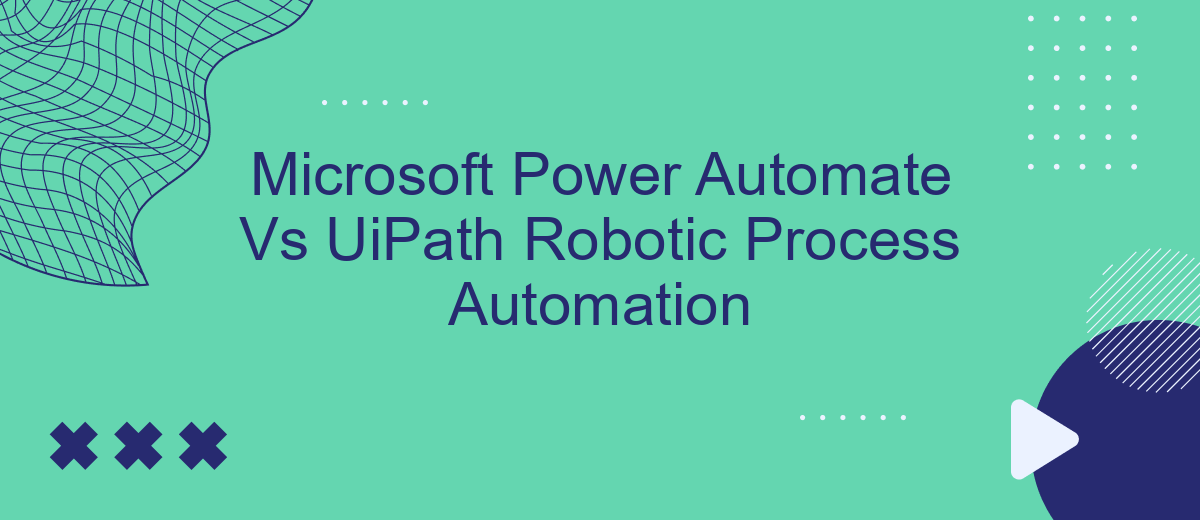In the rapidly evolving landscape of automation, Microsoft Power Automate and UiPath Robotic Process Automation (RPA) stand out as leading solutions. Both platforms offer robust tools for streamlining workflows and enhancing productivity. This article delves into a comparative analysis of these two powerful automation technologies, highlighting their features, strengths, and potential use cases to help organizations make informed decisions.
Introduction
In today's rapidly evolving digital landscape, businesses are constantly seeking ways to enhance efficiency and streamline operations. Two popular tools that have emerged as leaders in the field of automation are Microsoft Power Automate and UiPath Robotic Process Automation (RPA). Both platforms offer robust solutions for automating repetitive tasks, but they cater to different needs and use cases.
- Microsoft Power Automate: Ideal for integrating with other Microsoft products and services, offering a user-friendly interface for creating workflows.
- UiPath RPA: Known for its advanced capabilities in automating complex processes and integrating with a wide range of third-party applications.
Choosing the right automation tool depends on various factors such as the complexity of tasks, integration requirements, and user expertise. For instance, services like SaveMyLeads can further enhance the automation experience by providing seamless integration solutions, enabling businesses to connect various applications effortlessly. This introduction aims to provide a comparative overview of Microsoft Power Automate and UiPath RPA, highlighting their key features and benefits.
Capabilities Comparison

Microsoft Power Automate and UiPath Robotic Process Automation (RPA) both offer robust capabilities for automating business processes. Power Automate is tightly integrated with Microsoft’s ecosystem, making it an excellent choice for organizations already using Microsoft products. It provides a user-friendly interface and pre-built templates to simplify automation tasks. Power Automate excels in automating workflows across Microsoft services like Office 365, Dynamics 365, and Azure, and it also supports numerous third-party applications through connectors. Additionally, it offers AI Builder to incorporate AI into workflows easily.
UiPath, on the other hand, is a more specialized RPA tool that provides extensive capabilities for automating complex and repetitive tasks. It offers a rich set of features, including advanced process mining, task capture, and robust analytics. UiPath is known for its flexibility and scalability, making it suitable for large-scale automation projects. It supports integration with various third-party services and platforms, and tools like SaveMyLeads can further streamline these integrations. UiPath also offers a strong community and extensive training resources, which can be beneficial for organizations looking to upskill their workforce in RPA.
Strengths and Weaknesses

When comparing Microsoft Power Automate and UiPath Robotic Process Automation (RPA), it's essential to consider their strengths and weaknesses to determine which platform best suits your needs.
- Microsoft Power Automate
- Strengths: Seamless integration with Microsoft 365, user-friendly interface, extensive library of connectors, cost-effective for small to medium-sized businesses.
- Weaknesses: Limited advanced automation capabilities, less suitable for complex RPA tasks, dependency on Microsoft ecosystem.
- UiPath
- Strengths: Robust automation capabilities, highly scalable, extensive community support, suitable for complex enterprise-level automation.
- Weaknesses: Steeper learning curve, higher cost, may require more technical expertise.
Both platforms have their unique advantages and limitations. Microsoft Power Automate is ideal for businesses already invested in the Microsoft ecosystem, offering ease of use and affordability. UiPath, on the other hand, excels in handling complex automation tasks and scalability, making it a preferred choice for larger enterprises. For seamless integration needs, tools like SaveMyLeads can further enhance the automation experience by simplifying the connection between various services and applications.
Use Cases and Industries

Microsoft Power Automate and UiPath Robotic Process Automation (RPA) serve diverse use cases across various industries. Power Automate excels in automating workflows within the Microsoft ecosystem, making it ideal for businesses heavily reliant on Microsoft Office 365, Dynamics 365, and other Microsoft services. On the other hand, UiPath offers robust capabilities for more complex automation tasks, often involving legacy systems and intricate workflows.
Both tools find applications in industries such as finance, healthcare, manufacturing, and retail. They help streamline processes, reduce operational costs, and improve efficiency by automating repetitive tasks. While Power Automate is often used for simpler, rule-based automation, UiPath is preferred for more sophisticated, AI-driven automation projects.
- Finance: Automating invoice processing and financial reporting.
- Healthcare: Streamlining patient data management and appointment scheduling.
- Manufacturing: Enhancing supply chain operations and inventory management.
- Retail: Optimizing order processing and customer service workflows.
For businesses looking to integrate various applications and services seamlessly, tools like SaveMyLeads can be invaluable. They enable easy integration of different platforms, ensuring smooth data flow and enhanced automation capabilities. Whether using Power Automate or UiPath, leveraging such integration services can significantly boost overall efficiency and effectiveness.
Conclusion
In conclusion, both Microsoft Power Automate and UiPath Robotic Process Automation offer robust solutions for automating business processes, each with its own strengths and unique features. Microsoft Power Automate excels in its seamless integration with other Microsoft services and its user-friendly interface, making it an ideal choice for organizations already embedded in the Microsoft ecosystem. On the other hand, UiPath stands out for its advanced capabilities in handling complex automation tasks and its extensive range of pre-built automation components, which can be particularly beneficial for more intricate workflows.
Ultimately, the choice between Microsoft Power Automate and UiPath should be guided by the specific needs and existing infrastructure of your organization. For businesses looking to streamline their integration setup, services like SaveMyLeads can further enhance the efficiency of these automation tools by simplifying the connection between various applications and services. By carefully evaluating the features and compatibility of each platform, organizations can make an informed decision that best supports their automation goals.
FAQ
What are the primary differences between Microsoft Power Automate and UiPath?
Which tool is better for integrating with third-party applications?
How easy is it to set up and use these tools?
Can both tools handle unattended automation?
What are my options for getting started with automation if I lack technical expertise?
Don't waste another minute manually transferring leads from Facebook to other systems. SaveMyLeads is a simple and effective tool that will allow you to automate this process so that you don't have to spend time on the routine. Try SaveMyLeads features, make sure that this tool will relieve your employees and after 5 minutes of settings your business will start working faster.
